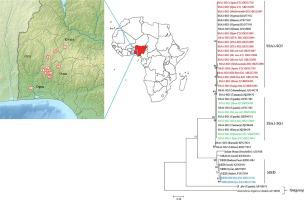Journal of Asia-Pacific Entomology ( IF 1.1 ) Pub Date : 2020-08-18 , DOI: 10.1016/j.aspen.2020.08.007 Ashraf Akintayo Akintola , Hwal-Su Hwang , Mst. Fatema Khatun , Adeolu Taiwo Ande , Kyeong-Yeoll Lee

|
Bemisia tabaci is a species complex of at least 44 cryptic species with a worldwide distribution. It is a serious pest of many crop plants as well as a successful vector of at least 100 begomoviruses. Using B. tabaci collected from cassava and tomato fields in the southwestern and north central regions of Nigeria, we determined nucleotide sequences from the mitochondrial cytochrome c oxidase subunit I (COI) of 23 B. tabaci samples, the 16S and 23S ribosomal DNA of endosymbionts, and the coat protein gene of geminiviruses ingested by the whiteflies. The COI analysis identified three different genetic groups including the indigenous Sub-Saharan Africa 1 subgroup 1 (SSA1-SG1) and 5 (SSA1-SG5, which was most prevalent), and an invasive cryptic species (Mediterranean). SSA1 was infected by five known secondary endosymbionts, Arsenophonus, Cardinium, Hamiltonella, Rickettsia, and Wolbachia, and co-infections with two or three endosymbionts were common. Five begomoviruses, okra enation leaf curl virus, squash leaf curl China virus, tobacco curly shoot virus, tomato leaf curl New Delhi virus, and tomato yellow leaf curl virus, were detected from 43.5% of the B. tabaci samples. However, cassava mosaic disease that causes devastating cassava yield losses was not detected in this study. This study improves the current understanding of the genetic diversity of B. tabaci cryptic species, and it reveals their relationships with endosymbionts and geminiviruses in the cassava and tomato fields of Nigeria.









































 京公网安备 11010802027423号
京公网安备 11010802027423号